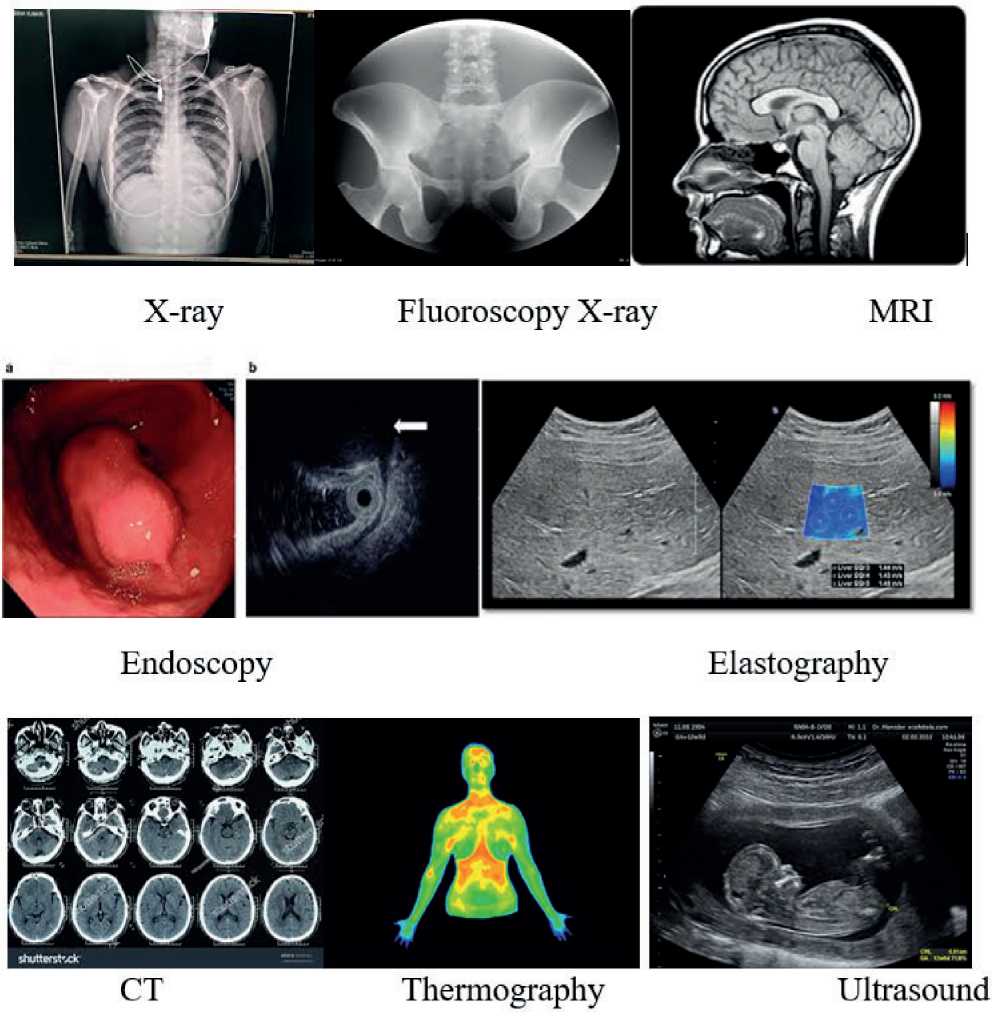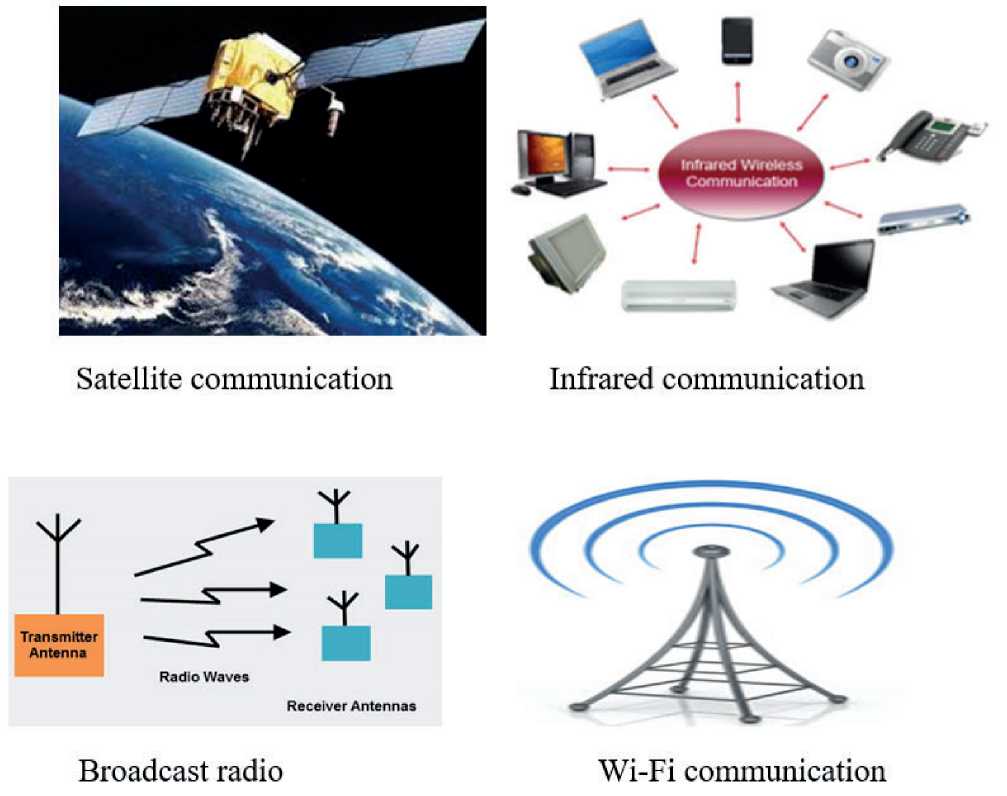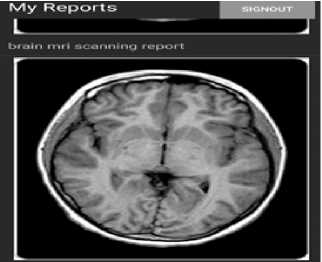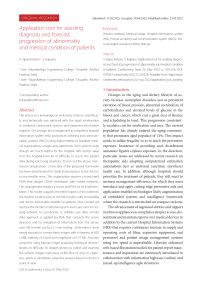Application tool for assisting diagnosis and forecast progression of abnormality and medical condition of patients
Автор: Kishore V.V., Kalpana V.
Журнал: Cardiometry @cardiometry
Рубрика: Original research
Статья в выпуске: 22, 2022 года.
Бесплатный доступ
The precocious knowledge on reckoning schemes scientifically and technically was replaced with the rapid amelioration in medicinal contrivance systems and treatment information registers. On average the management accomplishes hospital information system (HIS) and picture archiving and communication systems (PACS) using digital entities to maintain medical examinations, images and statements. Such systems even though are much helpful for the hospital staff, doctor away from the hospital have lot of difficulty to access the patient data during risk facing situations. To iron out the above-mentioned complications, a new idea of the proposed framework has been disseminated for medical descriptions to the doctors at inaccessible areas. This organization requires a hand-hand PDA’s that adopts CDMA techniques with mobile networks. This arrangement requires a server and PDA for its implementation. This model supports the entire reports of the patient to the doctors located even at remote location with accessibility and doctor information reliable for patients. PDA created will disclose the inmate’s medicinal reports and scans over an outlying network. To corroborate or validate user data, remote data approach is applied by PDA that connects the server directory and for relegation of information from the server, uses file transfer protocol. From testing, observations show ninety seconds to convey thirty images with a fineness of 832 x 488, intensity of 24 bits and magnitude of 0.37 Mb. This idea proposed using bitmap image acquiring technique demonstrates no difficulty for distant doctors to collect and examine the sufferer images right away at the time of crisis or urgencies, which is completely subjective analysis based on doctor’s point of view.
Wireless network, medical image, hospital information system (his), picture archiving and communication system (pacs), personal digital assistance (pda), bitmap
Короткий адрес: https://sciup.org/148324639
IDR: 148324639 | DOI: 10.18137/cardiometry.2022.22.520526
Текст научной статьи Application tool for assisting diagnosis and forecast progression of abnormality and medical condition of patients
Changes in the aging and dietary lifestyle of society increase incomplete disorders just as persistent elevation of blood pressure, abnormal metabolism of carbohydrates and elevated levels of glucose in the blood, and cancer, which cost a great deal of finance and scheduling to treat. This progression consistently escalates cost for medication and cure. The current population has already entered the aging community that permeates aged populace of 14%. This impact needs to inflate frugality so as to reach the preventive expenses. Insistence of providing such disinfectant assistance figures copious expenses. In the direction, particular issues are addressed by recent research on therapeutic aids adopting computerized estimation automations just as universal (anytime, anywhere) health care. In addition, although hospitals should prioritize the treatment of patients, they still need to increase management efficiency, for which they must introduce and apply cutting-edge preventive aids and application-enabled technologies likely augmentation of embedded systems and intelligence framework where the research is entrenched on compact reckons.
The advancement of ingrained entities and rapport machines/appliances accomplishes simpler access, disseminate and maintain reports over medical devices in addition to the current Hospital Information Systems (HIS) that requires continuous increase in supply and operating costs of films, expensive equipment, and personnel and patient image management systems using low speed is unprofitable. Likewise enhanced web-based illustration models for patient report maintenance and inquisition are extensively introduced in collaboration with information highways (online) and jazzed-up intelligence agile structures.
-
2 Literature Survey
The unification of miniature sensor automation with radio communications pursued multifarious relevance of embedded systems ensuring communal framework and eco-friendly ambiance to induce robust wireless monitoring in the field of medicine. These monitoring prototypes empowered by PDA-based wireless sensor network oversee periodic changes in the physical attributes of elderly or impaired people with the help of a hospital. These cases can be continuously monitored incidentally and sustained with appropriate emergency assistance. Besides, this mechanism curtails medical expenses in the community and also upturns viability expectancy [1]. M-Health exemplifies mobile computing, medical sensor, and communications technologies for health-care. This emanated conception represents the transformation of health care systems via e-health into sophisticated arrangements that guarantee wire-less and mobile outlining applications.
Present and ameliorated augmentations infused mobile systems that incorporate ubiquitous and wearable technology with extremist effect on tomorrow’s health care consignment conformities [2]. Versatile patient tracking modules through mobile assimilates personal digital assistant (PDA) technology and wireless local area net-work (WLAN) technology. At the patient’s tract, PDA equipped wireless monitor system pursues the patient’s imperative signals along with heart beat and ECG. With underlying Wi-Fi alliance, WLAN media communicates these bio signals to main administration group (hospital/doctor) at remote end. The conveyed medical history is accessed by approved curative crew from a machine that is analytically proven and scientifically confirmed to be specialized [3]. An easy to understand multifunctional GUI Device for CAD that performs intelligent preparing of lung CT images is designed. A common frame work for extracting ILD patterns is developed that highlights the medical image ROI segmentation that delineates the diseased part using morphological algorithm. This paper addresses working on reliable methods for diagnosis and prognosis of the pulmonary diseases [5].
-
3 Medical Delineations
Any image is described as a depiction that is conceived or reproduced and stocked in electronic fashion or as raster form so called as bit array or bitmap. This form of representations holds detailed data that accompanies hypertext links that provides single user interface [4]. Frequently available dossier layouts are JPEG (Joint Photographic Expert Groups), GIF (Graphics Interchange format), GIF89a or Animated GIF, PNG (Portable Network Graphics), SVG (Scalable Vector Graphics) and TIFF (Tag Image File Format). Medical interpretation in digital health invokes approaches and developments that help to construct counterparts of body organs and its reflections for problem identification and proper medication [6]. It comprehends assorted ionizing radiation procedures like X-ray radiography, Fluoroscopy, Magnetic resonance imaging (MRI), Medical ultra sonography or ultrasound, Endoscopy, Elastography, Positron emission tomography (PET) and CT scan [7]. Various medical modalities have been picturized in Figure.1.
X-ray radiography: These rays emit radioactive energies in the nature of electro-magnetic emission having wavelength less than UV rays and greater than gamma rays that vary between 0.1 to 10 nanometers analogous with frequencies from 30 petahertz to 30 exahertz (3×1016 Hz to 3×1019 Hz) and intensities dimensions are 100 eV to 200 keV [8].
Fluoroscopy: Fluoroscopy is a type of medical imaging that passes X-ray beam through the anatomy displaying the body movements as a continuous X-ray image on a monitor.
Magnetic resonance imaging (MRI): Magnetic resonance imaging (MRI) uses a considerable material like neodymium that produces magnetic field and emit radio waves to project on body organs for diagnosing diverse requirements like abnormal growth and analyze other parts such as brain and spinal cord.
Medical ultrasonography or ultrasound: Ultrasound imaging is non invasive and employs acoustic waves to recognize organ infections, interpret the conditions and growth of baby in pregnant women and can generate reports on the evaluation of injury after heart attacks. This is considered to be intact as it will not use any ionization emissions.
Endoscopy: This nonsurgical procedure probes human digestive section through a narrow duct attached with a light and camera for doctors to view the digestive track on a screen.
Elastography: This approach diagnoses the features of soft tissues and the condition of the ailment when compared to the hardened infected body with normal one.

Figure 1. Radiological Imaging Modality Scans Patterns
CT scan: This examination works with data processing machines and X-ray machines that twists and moves circularly to generate random samples of patient that furnish specific knowledge, when combined they can even yield 3D data. It also ensures relevant information about soft tissues, blood vessels, and bones as well. It visualizes Head, Knee, Abdomen, Shoulders, Spine, Chest and Heart by creating image slices from different angles.
Thermography: This procedure examines thermic characteristics of perceived matter taken from infrared illustrations which acknowledges radiated strength of heat through the volume.
Positron Emission Tomography (PET): This involves radioactive decay energies which is called as
522 | Cardiometry | Issue 22. May 2022
nuclear imaging approach. It imbibes chemical process of a living organism for detection of disorder. Contemporary PET scanners facilitate 3D images from the identical machine at the same time
-
4 Wireless Network
Cellular systems are based on organization of programmable electronic devices that are further employed without use of links. The benefits of wireless connections empower resources and its operations reasonable as it lying of cables between the entities. The physical foundation of wireless communication technology relies on electromagnetic waves or radio frequencies [9]. Four classes of radio networks are Wire-less Local Area Network (LAN): Connects assorted devices with connectionless sharing associating the entry points with ample information gateways, Wireless Metropolitan Area Networks (MAN): Consociates different wireless LANs, Wireless Wide Area Network (WAN): Overlays massive distances essentially incorporated communities and metropolis, Wireless Personal Area Network (PAN): Ascribes connections to appliances and gadgets that are abridged in range [10]. Wireless network has its wide range applications in satellite communication, infrared communication, and broadcast radio and Wi-Fi communications as shown in Figure 2.
-
5 Prospective Implementation
Unlike existing technologies, PACS and HIS that require lot of time for the patients to wait for the reports which is waste of time. This technology proffered can be able to disseminate images that are acquired from the hospital imaging systems through CDMA communication network [11]. This appli- cation-oriented technology can help doctors to upload the reports as soon as they get them so that the patient can view them at anytime from anywhere without wasting time. For this, the system requires a computer for specific applications and PDA where the server is meant to maintain the accounts of physician and victim and to convey the inmate pathological information to the doctors and the PDA to exhibit the victim reports by a wireless server network. This PDA uses remote data access, RDA for authentication of users and file transfer protocol, FTP to download the images from the remote server [12]. By using the same technology of CDMA, patients can check their uploaded reports and images at any moment. It is the smart way of storing documents and there is no need for the patients to visit hospitals daily and doctors can suggest them through online [13]. Mainly minimum numbers of administrators are enough for scanning rooms.
This application uses android studio and bit map techniques for acquiring images [14]. The main ad-

Figure 2. Pertinence of Wireless Networks
vantage of this interpretation is that the user or patient can search for doctor’s help at any instant, they can talk about their illness and get immediate diagnosis and prognosis and even the doctors can get more clients online [15]. The software used for the implementation uses ANDROID STUDIO 3.3 with additional Toolboxes and it is an open-source software that can be collected from the Internet [16]. The android operating system is the world’s best smart phone platform and is installed from the ADT plug in for the Eclipse for developing Android applications and also for the development of programming with adding of some additional plat-forms and other components [17]. Some techniques (bit map) are used for acquiring the Images. Patient Scanning reports are stored in the CLOUD and patient data can be stored with the help of SQL Data base [18].
-
6 Results
With empirical improvements and province in applied sciences and automation, medical field has alleviating and ingenious concerns for the well being of the society. The viewpoint of this paper discusses the fringe benefits pertaining to assistance in detriment situations. The intact process is accessible, convenient and is ceaselessly assisted by an android mobile in a slant perspective. At the inceptive, doctor will upload patient details into the cloud via PHP server which is flexible for patient and doctor interaction. This app can provide both biological information and physical information of the patients. Even though this is a subjective analysis it is an authentic constructive in doctor’s view.
The Figure 3 shows the Patient list for doctor. The application we have developed is carried out on AN-

Step 1 Step 2

-
S.3- Patient list for doctor Description-MRI scan Upload scan reports

Step 4
Figure 3. Patient list for doctor
DROID STUDIO using a computer and also using mobiles for the sending and receiving of medical reports. It accomplishes the following steps:
Step 1: Login page with Email Id (either as doctor or patient).
Step 2: If “Not a Member” use “Sign Up” (either as doctor or patient).
Step 3: Doctor uploads scanning reports in the upload page through his login by selecting the available patient lists and leave a message for patient by entering his / her name in dialogue box.
Step 4: Patient can view scan reports and can leave message to doctor and sign out.
-
7 Conclusion
When the world is emerging rapidly in all the fields, the recommended approach has beneficial societal impact. Even the medical field is yet to be developed vastly; the proposed application can store and retrieve patient reports contemporarily with the help of internet and an android mobile. This is much faster and safer and will save lot of time. Patients can also have their secondary opinion on their reports and can also access them in case of emergencies like COVID-19 where isolation is must. Therefore, this illustration from medical communication system contributes as an infrastructure for succeeding systems through which doctors can oversee and interpret multifarious bio signals at any place and time pertaining as disintegrated or unified unit. The tools for integration of segmentation, extraction and classification of images can be developed. The segmentation of image (ROI) can be done using different algorithms in order to obtain gradient of the image. The security to the cloud that stores information of the patients and the app can be improved so that images can be acquired a lot more and research can be done further in this field.
Statement on ethical issues
Research involving people and/or animals is in full compliance with current national and international ethical standards.
Conflict of interest
None declared.
Author contributions
The authors read the ICMJE criteria for authorship and approved the final manuscript.
Список литературы Application tool for assisting diagnosis and forecast progression of abnormality and medical condition of patients
- Choplin R (1992). “Picture archiving and communication systems: an over-view”. Radiographics. 12: 127–129. doi:10.1148/radiographics.12.1.1734458.
- Potter, B., “Wireless security’s future”, IEEE Security and Privacy, 1(4):68–72, 2003.
- R. Prasad and Ruggieri, Marina. “Technology Trends in Wireless Communications,” Ar-tech House Publishers. April 2003.
- V.Vijaya Kishore, R.V.S. Satyanarayana, “GUICAD Tool for Segmentation and Classi-fication of Abnormalities in Lung CT Image,” International Journal of Biomedical and Clinical Engineering Volume 8, Issue 1, January-June 2019.
- Kalpana V., Vijaya Kishore V., Praveena K, “A Common Framework for the Extraction of ILD Patterns from CT Image,” Emerging Trends in Electrical, Communications, and Information Technologies. Lecture Notes in Electrical Engineering, vol 569. Springer, Singapore. https://doi.org/10.1007/978-981-13-8942-9_42T.
- Tan, B. Bing, S. Herry, “Worldwide Wi-Fi: Technological Trends and Business Strate-gies,” John Wiley and Sons, 2003.
- Istepanian, R. S. H., Jovanov, E., And Zhang, Y. T., Guest Editorial Introduction to the Special Section on M-health: Beyond Seamless Mobility and Global Wireless Health-care connectivity. IEEE Trans. Inf. Technol. Biomed. 8:4405–414, 2004.
- Hong, J. H., Kim, N. J., Cha, E. J., And Lee, T. S, “Development Brief of A body Area Network for Ubiquitous Healthcare: An Introduction to Ubiquitous Biomedical Systems Development Center,” J. Biomed. Eng. Res. 26:5331–335, 2005.
- Balachandran, A., G. M. Voelker, and P. Bahl, “Wireless hotspots: current challenges and future directions,” Mobile Networks and Applications, 10(3): 265-274, 2005.
- C.Basios; and Solidakis, M., “Current trends and challenges towards wireless Internet,” Computer Systems and Applications, 2005. The 3rd ACS/IEEE International Conference on 2005 Page(s):77.
- Lerdorf, Rasmus (2007-04-26), “PHP on Hormones – history of PHP presentation by Rasmus Lerdorf given at the MySQL Conference in Santa Clara, California,” The Con-versations Network. Retrieved 2009-12-1.
- Gonzalez, Rafael (2018). Digital image processing. New York, NY: Pearson. ISBN 978-0-13-335672-4. OCLC 966609831.
- php: hypertext preprocessor. www.php.net. Retrieved 2020-02-12.
- Introduction to Android: http://developer.android.com/guide/index.html.
- Android API: http://developer.android.com/reference/packages.html.
- Android Fundamentals: http://developer.android.com/guide/components/fundamentals. html.
- Android User Interfaces: http://developer.android.com/guide/topics/ui/index.html
- Android Training: http://developer.android.com/training/index.html.


